Hey there, Key again!
Did you know that building a Value Ladder could help you make more money from the SAME AMOUNT OF CUSTOMERS coming into your world?
Understanding this concept allows you to outspend your competitors, escape the price-down war, and serve your customers at a higher level.
In this article, I’ll share everything you always want to know about the Value Ladder:
- What is it?
- Why does it work so well, no matter what industry or niche you’re in or what product or service you sell?
- How to create and implement a Value ladder in just hours (not weeks and certainly not months).
- Protect it from a “Value Maze.”
- Best ideas and real-life examples.
Now, Let’s get started!
Key Takeaways:
- Value ladder is a marketing concept that maps products and services to guide customers through offers.
- Creating an effective value ladder requires considering customer needs, logically progressing value/price, and avoiding common mistakes.
- Value Ladder isn’t about making a bunch of offers that confuse your customers. It may lead your business to become a value maze.
- Creating A Value Ladder is about creating offers for your business with rules.
- You don’t need to complete the macro Value Ladder in the beginning. Instead, build a sales funnel for your core product (micro Value Ladder).
What is a value ladder in marketing?

The Value Ladder (AKA sales ladder) is an organized way to move your customers through your offers. As customers ascend your Value Ladder, you’ll provide more value, so your offer will increase in price. At the same time, your customers find solutions for their needs and solve their problems better.
The first time I heard about this concept was in the Dotcom Secrets book by Russell Brunson, and it changed my business life forever.
Nowadays, the Value Ladder concept become more popular in the marketing industry. It’s a must-have for me, my friends, and my clients before we build anything online.
A Value Ladder is one business theme. You should focus on creating one strong theme throughout a company’s product line rather than many unrelated offers.
Clickfunnels went from ZERO to 9-figure in less than three years.
What Does A Value Ladder Look Like?
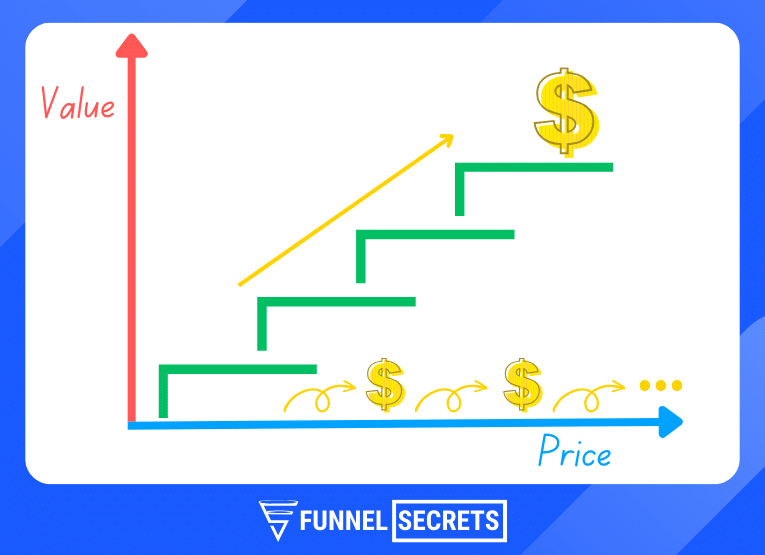
If you haven’t seen the Value Ladder before, it includes three or four steps and visually shows how you’ll ascend your customers. The number of steps and what you offer on each step varies based on your business type.
- On the left-hand axis, you have a value: As the arrow goes up, the higher the value is.
- On the bottom axis, you have a price: As you go to the right, it gets more expensive.
- On the left-right-hand corner is the big $ sign: This is where you can provide the most value and charge them the most.
From my experience, in most businesses, we bring dream customers in on the lowest level of Value Ladder with a free offer (training, ebook, or free report) where they can get some value. If they get value from that interaction, they’ll want more and start to ascend up your value ladder, buying other products or services.
Picture this: You have an amazing coaching program that could help change somebody’s life. What if you walk up and see your target audience on the street for the first time and invite them to something like:
“Hello, I’m John. If you give me $2997, I promise to help you get more customers as you always dream of and skyrocket business growth.”
Chances are, they’d think you’ve lost your mind! 😂
Why? Because you have no value at this point. Unfortunately, this is precisely what many business owners are doing – Pitching the most expensive offering without providing any value beforehand. And it’s no wonder people aren’t interested.
Instead, you should be thinking this way.

Start With A Free Offer (Bait)
The Free Offer (bait or lead magnet) is at the bottom of the Ladder, which aims to build trust with your potential customers and show them that you are an expert in your field. The goal here is to collect their email address.
It could be a newsletter, a free sample ebook, how-to videos, audio exercises, a free introductory course, a webinar, and more.

Pro tip: It’s easy to see over 100 free offer examples inside the Lead Funnels Swipe File. Get it here to confidently build your lead magnet like a pro.
The key is ensuring your free offer matters to your potential customers. When you give them something valuable for free, they’ll feel obliged, trust you more, and maybe even buy from you.
👉 Do you want to know how to build a Free Offer? Check out our guide to Lead Magnet:
Remember: You should provide the most valuable as possible inside your free offer. Don’t try to give away a sucks course or an ebook with 5 pages about the author and 2 pages for information with many upsell links. This is the fastest way to lose customers.
Front-End Offer
Once a prospect engages with our free offer, it’s time to introduce the Front-end Offer. This is often a low-priced product or service that converts leads into customers.
By making it affordable and valuable, we encourage customers to make their first purchase starting their journey with our brand.
In Funnel Secrets, after “Funnel Hack” and analyzing over 100 funnels, we found there are two methods most business owners use to promote the Front-end offer:
1. Use a Tripwire Funnel: This funnel offers a very low-priced product (usually less than $17) to entice prospects to buy. The product usually relates to the main offer and provides some value but not the full solution.
The goal of this funnel is to break the barrier of trust and get the prospects to enter their credit card information. Once they buy the tripwire product, they are presented with an upsell offer – a higher-priced product or service that provides more value and solves their problem.
The upsell offer is optional but increases the average order value and the customer lifetime value. Depending on the customer’s behavior, a tripwire funnel can have multiple upsells and downsells.
For example, Offers a book for $7 and then an upsell for a video course for $197.
2. SLO (Self-Liquidating Offer): A low-priced offer on the Thank You page (often $27-$97) after people give you their email address. SLO helps you liquidate your ad cost so you can break even quickly and re-invest in your ads again.
For example:
- After people register for a free challenge: Invite them to upgrade to VIP for $37.
- After people register for a free summit: They get lifetime access to the video recording for just $97.
- After people get your free report: Invite them to try your service for free or get a discount.
Middle-End Offer
The middle-end offer provides a more advanced and valuable product or service to address their growing needs. This stage is designed to match your customers’ evolving requirements, who are now more familiar with your brand and have greater trust in your offerings.
As such, the middle-end offer often includes higher-priced products or services that build upon the value provided in the front-end offer, allowing customers to invest more money for enhanced benefits.
Imagine you have a favorite snack, like chocolate chip cookies.
- Front-end offer: You try and like some cookies from a brand you’ve never had before.
- Middle-end offer: As you enjoy those cookies, you start to trust that brand more. You know their cookies are good. So, they offer you something even better – like a big box of different cookie flavors, including your favorite chocolate chip.
It’s a step up from the first cookies, and it might cost a bit more, but you get more cookies and variety.
The middle-end offer is like a bridge between the first cookies and something even more amazing they might offer in the future, like a “super fancy gift box” with all kinds of cookies and extras.
They want you to keep choosing their cookies, so they make these better offers as you become a loyal customer.
Doing this makes you happy because you get better cookies, and they make more money because you’re buying more from them.
Back-end Offer
At the top of the Ladder is our Back-end Offer, which is designed to cater to our most dedicated and loyal customers. These premium offerings often come with higher price tags and exclusive benefits, allowing businesses to maximize their customer lifetime value.
Here’s what makes it special:
- One-on-One Coaching: It’s like having a personal coach just for you. They help you get really good at something you love, like a sport or a hobby.
- High-Ticket Masterclasses: These are super cool classes with experts. You learn amazing stuff that can make you even better at what you enjoy doing.
- Custom Solutions: This means we create something just for you. It’s like having your own customized video game or a special tool that uniquely helps you.
These special things might cost more, but they’re super valuable. Businesses do this because they want to make their customers happy. When those customers are satisfied, they stick around for a long time, which also helps the business do well.
So, the Back-end Offer is like the VIP section of our Ladder, where we give our very best to the people who love what we do the most!
Continuity Program (Or subscription)
You always want to have an upside beyond the monthly revenue.
Recently, after reading the Linchpin book, I realized many people (including me) are not drawing the Continuity Program in our Value Ladder – It’s a huge mistake.
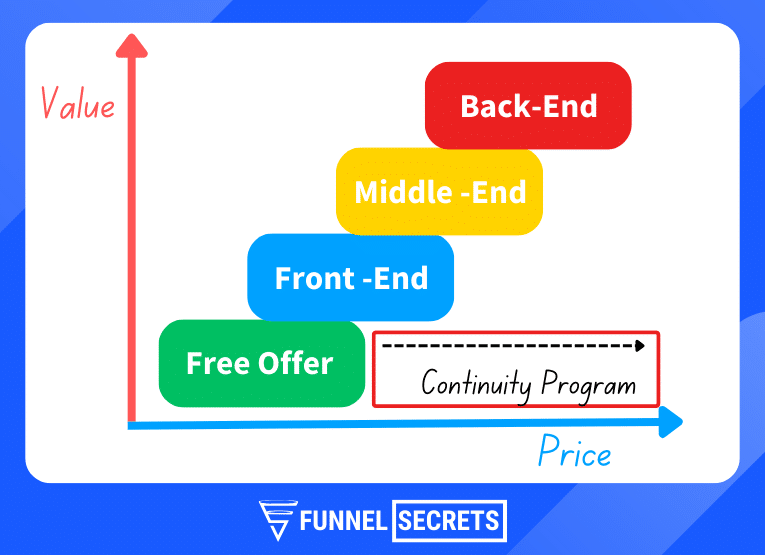
Bill Glazer and Dan Kennedy mentioned we were in a “two-things” business.
- The business of getting members.
- The business of keeping members.
See, to two of the smartest marketers to ever live, it’s NOT about niche, industry, or product…
It’s all about creating CONTINUITY.
With continuity or subscription programs, your members pay you on a recurring schedule (monthly, 6 months, or yearly) until they cancel. This means you have a steady stream of income flowing into your business, which allows you to plan for the future and invest in growth.
And the best part?
Investors love companies with predictable cash flow, so having a subscription program can make your business even more attractive to potential backers.
Here are some ideas for the continuity program:
- Membership sites – Exclusive content, resources, or services to members who pay a recurring fee.
- Software as a service (SaaS) – Develop a software product that customers can access through a subscription-based model.
- Coaching or consulting services – Provide ongoing coaching or consulting services to clients who pay a monthly fee.
- Subscription boxes – Create a subscription box service that delivers customers a curated selection of products regularly.
- Meal delivery services – Offer a meal delivery service that customers can subscribe to and receive standard deliveries of healthy, pre-made meals.
- Fitness programs – Develop a fitness program that customers can access through a subscription-based model.
- Beauty or grooming products – Delivers beauty or grooming products to customers regularly.
- Pet care services – Offer a subscription service that provides regular pet care services like grooming, walking, or feeding.
Macro & Micro Value Ladders (Strategy)
There are two types of Value Ladder in your business:
Macro Value Ladder: This is the big picture of your business. It shows all the products or services you offer your customers, from the lowest-priced or free ones to the highest-priced or premium ones. Your macro value ladder helps you to create an ecosystem of products or services that work together and complement each other.
Here’s the Macro Value Ladder of Clickfunnels Company:
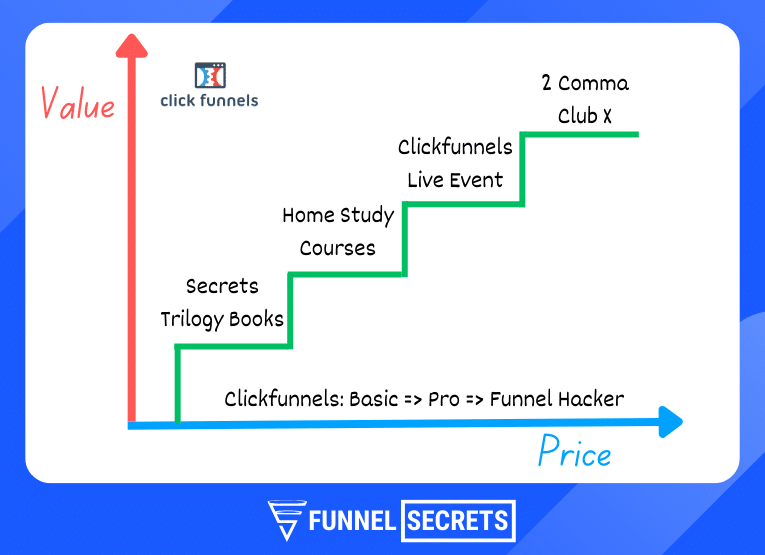
Micro Value Ladder: This is a smaller version of the Macro Value Ladder that focuses on a specific product or service. It’s also known as the Value Ladder inside the Value Ladder or sales funnel.
For example, see the Micro Value Ladder for the Traffic Secrets Book below.
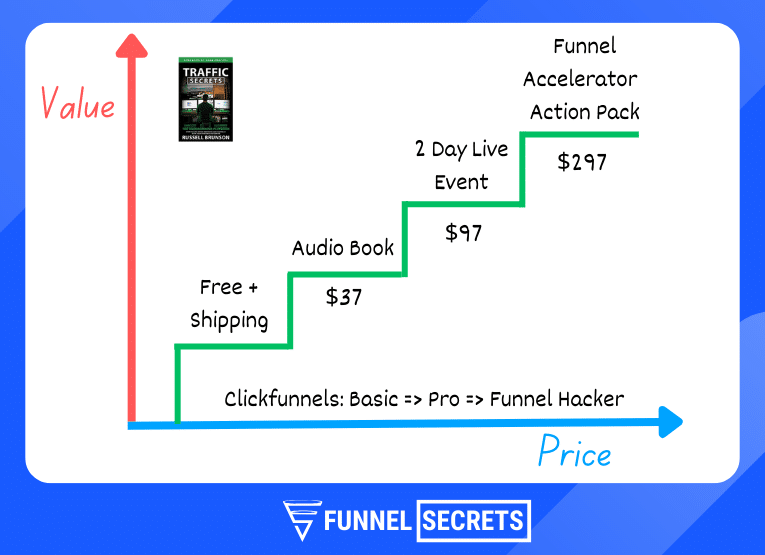
Simply put, Value ladders guide your customers through your funnel – they provide value and extract revenue simultaneously.
Why Does Your Business Need A Value Ladder?
From my experience, there are two main reasons why you should build the Value Ladder in your business:
- The Value Ladder is your business plan, which helps you understand the customer’s journey easily.
- Following your Value Ladder plan allows you to get more money from the same number of customers.
Watch the video below to see Russell Brunson – CEO of Clickfunnels, explain why businesses must have it.
Value Ladder Is Your Business Plan
Value Ladder outlines the client’s journey from the first contact to the final sale. It also helps you to create products or services that match the needs and wants of your customers at different stages of their relationship with you.
I love using the Value Ladder concept in my marketing. It makes everything so much easier and clearer.
Instead of writing a long and boring marketing plan, I just draw a simple diagram of my Value Ladder and share it with my team, partner, or investor. They get it immediately and can see how my business works, where we’re going, and what we need to focus on.
It’s like magic!
Maximize Profit and Scalability
Ultimately, the business that can spend the most to acquire a customer wins
Dan Kennedy
A value ladder is key to building your funnels. It visually maps out your product/services in ascending order of value and price. The 2 most important reasons for creating a value ladder are
- Average Order Value (AOV)
- Lifetime Customer Value (LCV).
A value ladder allows you to create related products for upsells and downsells that increase the value you deliver, increasing your customers’ average order value and lifetime value (LTV).
Once you have more Lifetime Value of Customers than competition, you can spend more money on advertising on the front end to bring more people into your business than anybody else.
You win the game!
How Do You Create A Value Ladder?
Creating a Value Ladder for your business, whether for a coach, SAAS, author, dentist, or eCommerce business, is not as complicated as it seems. Follow my 4 simple steps to build your own Value Ladder within 1hr (or less).
Step 1: Identify The Value Ladder Mission Statement (VLMS)
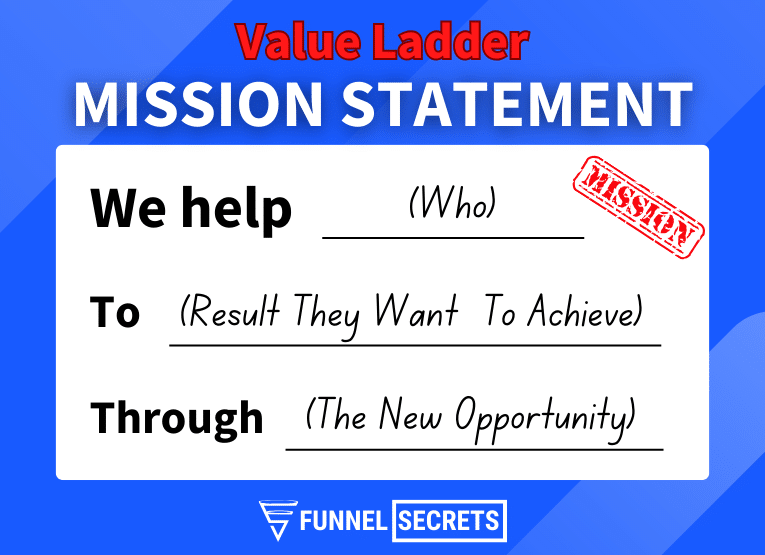
First, let’s define the mission statement of our value ladder. This involves identifying the needs of our target market and determining how our products or services will address those needs.
Think about the unique value proposition that sets us apart from the competition. Here’s the formula:
We Help [who] To [resurt they want to achieve] Through [the new opportunity].
For example, our mission statement could be:
“We help families in our communities to increase their confidence through creating a beautiful smile they’re proud to share.“
“We help Marketers to increase leads and sales online through sales funnels.“
“We help our clients to take control of their well-being, shed unwanted pounds, and lead healthier lives through Keto.“
Now, all of your books, courses, coaching programs, and all separate offers you create on the value ladder are helping to fulfill the Mission Statement.
In this way, you can avoid creating unrelate offers, which make your Value Ladder become a Value Maze where customers get lost.
Step 2: Create an Offer At Each Tier Of Your Value Ladder
Once you have the VLMS, it’s time to create an offer in each tier of the Value Ladder. Before you start brainstorming, remember that your offer should cater to the needs of your target audience and align with the mission statement you have set above.
Doing so will provide value to your customers and establish a strong brand identity that resonates with your audience.
Don’t worry if your products or services aren’t ready; just write your ideas now, and you can build them later.
1. What Offer Could You Create To Give Away To Attract Dream Customers?
- Ebook
- Whitepaper
- Check List/Cheat Sheet
- Quiz/Survey
- Resource list
- Templates
- Toolkit
- Or Case Study?
2. What Offer Could You Create To Sell At The Front-End?
- Low-cost ebook
- Entry-level course
- Starter Pack or Bundle
- Live event video recorded
3. What Higher Price Offer Could You Create To Sell At The Middle-End?
- Comprehensive Course
- Live Event
- Premium Membership
- Advanced Toolkit or Template Bundle
- Certification Program
- Premium Digital Product
4. What High-Ticket Offer You Could Create To Sell At The Back-End?
- Done For You Service
- 1-on-1 Coaching Program
- Mastermind
- Or Private Consulting Package?
Pro tip: If you’re still confused about how to structure your Value Ladder, you can think about it this way:

- Do It Yourself: Customers are given information and tools to achieve their goals independently. They are responsible for implementing the information and completing the task alone.
- Done With You: Customers receive more support and guidance through home study courses, coaching, consulting, or membership programs. They still do the work but have more assistance and accountability.
- Done For You: Customers get a complete solution to their problem or goal. This can be a service where they hire you or your team to complete the task. Customers no longer have to do the work but pay for a delivered solution.
Step 3: Choose a Starter Place
After learning the Value Ladder concept, I found many people try to create all the stuff inside:
- Coaching Program
- Live event
- Home study course
- Free stuff
- Etc
Please, DON’T DO THAT!
The Value Ladder is your business plan. This is where we’re going, NOT where we are today. So, You don’t have to make everything on your value Ladder right away. That would take too long and be too hard. You should start with one thing that you offer and make it really good.
At each step of the Value Ladder, we have a funnel to use. Inside Dotcom Secrets book, Russell recommends we Pick one thing on the Value Ladder, build a funnel, and work on it until we make at least $1M.
Then, you can launch the next funnel, and so on. That’s how you can use your Value Ladder to grow and scale your company online.
My recommendation: Start with the Middle or Back-end Offer. The price at that high level is high enough to cover your ad cost and make a profit.
Step 4: Build a Sales Funnel
Earlier, as we discussed above, a Micro Value Ladder is actually a sales funnel.
Because we have different offers on each tier of the value ladder, starting with cheaper things and going up to more expensive ones. So, we’ll use different types of sales funnels to sell every kind of offer.
Tier of the Value Ladder | The Funnel We Could Use |
|---|---|
Free Offer | – Squeeze Page Funnel – Reverse Squeeze Page Funnel – Lead Magnet Funnel – Quiz/Survey Funnel – Summit Funnel |
Front-End Offer | – Tripwire Funnel – Unboxing Funnel – Challenge Funnel |
Middle-End Offer | – Video Sales Letter Funnel – Sales Letter Funnel – Webinar Funnel – Invisible Funnel – Product Launch Funnel |
Back-End Offer | – Application Funnel |
Best Value Ladder Examples
We believe that reading information about value ladders is not enough for you to understand them well. Therefore, we have listed some of the best value ladders below to analyze and demonstrate the information released earlier.
Marketing Service Value Ladder

Coaching Value Ladder

Coaching valuable ladder can be exclusively applied to today’s online courses. It is a unique product that brings impressive supplier profits as well as a large number of students. The ladder will go through 4 different stages: Books, online courses, online events/conferences, and finally, 1-on-1 coaching.
You can understand that Coaching Value Ladder acts as customer orientation and provides experience to them before deciding whether to use the course or not. And of course, when they join the 1-1 course, it will bring you a more stable and reasonable profit.
Dentist Value Ladder

The value ladder is also widely applied in the medical field, specifically the Dentist Value Ladder. Specifically, by making judgments about the quality of your customers’ teeth, directing them on how to make their teeth white and strong, and ultimately directing them to your oral care products.
For the dentist value ladder, you need to use your expertise to change their minds and make a quick final judgment on your product.
How Do I Learn More About The Value Ladder?

The best book on the Value Ladder concept is Dotcom Secrets by Russell Brunson. This book is a must-read for anyone who wants to master sales funnels and value-added marketing. In this book, you’ll discover:
- The basics of the value ladder and why it’s so effective
- How to design different types of funnels for each step of the Ladder
- How to ascend your people from Tier 1, to Tier 2, to Tier 3 (and so on)
On the other hand, if you want to learn faster and have more fun, there’s another option for you. It’s called the Funnelology Masterclass. This course is an online training that dives deeper into sales funnel building.
In this course, you’ll learn:
- Master the Value Ladder, how to create a bunch of offers on each step and avoid it becoming a Value Maze
- ALL NEW funnel building hacks, lead gen and sales strategies, and never before revealed secrets.
- The 10 core funnels you need to launch and grow your company.
- An EXACT way to find your own “honey hole” of golden clients.
- AND MUCH MORE
Unfortunately, Funnelology isn’t currently accessible. You’ll need to go through the upsell page within the funnels and templates funnel to get your hands on it.
Conclusion
I hope you enjoy my Value Lader guide!
In short, the Value Ladder gave me another language to describe my business plan so I could easily share it with my team and partner.
Remember: The Value Ladder is more than just a product hierarchy. It’s a strategic journey for customers, meeting their needs at each step with transformative solutions. Each rung offers an irresistible, increasingly valuable experience. It’s not just selling but serving and building lasting relationships.
For me, Value Ladder is a roadmap to mutual success and fulfillment.
Frequently Asked Questions
Who created the value ladder?
It’s difficult to pinpoint the person who created the value ladder right now. From my research, Russell Brunson pioneered and popularized the concept of Value Ladder.
How does a clothes brand use a Value Ladder?
A clothing brand can use a value ladder to guide customers through a series of purchases, each offering more value than the last. Here’s an example:
– Free or Low-Cost Item: Attract new potential customers by giving away a branded keychain or a pair of socks. This is a low-risk way for customers to try out the brand.
– Basic Clothing Items: These inexpensive items offer more value than the initial free item.
– Mid-Range Clothing Items: These items are more expensive and provide more value in quality and style.
– High-End Clothing Items: The brand could offer high-end things like premium clothing lines, limited edition collections, and custom design options.
– Membership program: The brand could provide early access to new collections. Customers are ranked based on their purchases, ascending from basic to gold and finally to diamond. Each level unlocks discounts and exclusive benefits, providing a VIP shopping experience.
What is ascending the value ladder?
Ascending the Value Ladder is a marketing strategy where companies offer products or services in increasing order of value and price. They start with the cheapest or free product and progress to the most expensive one. The aim is to acquire and retain customers by providing progressively more valuable products.
👉 Read next
- Step-by-step guide on how to build a sales funnel
- What is a digital marketing funnel
- Hook, Story, and Offer framework

Author
Key Nguyen
Key is the brainchild behind Funnelsecrets.us. You’ll often find him analyzing conversion rates, tweaking landing pages, and exploring new marketing automation software. He loves to write about sales funnel building and is always tinkering with the latest conversion optimization techniques!


